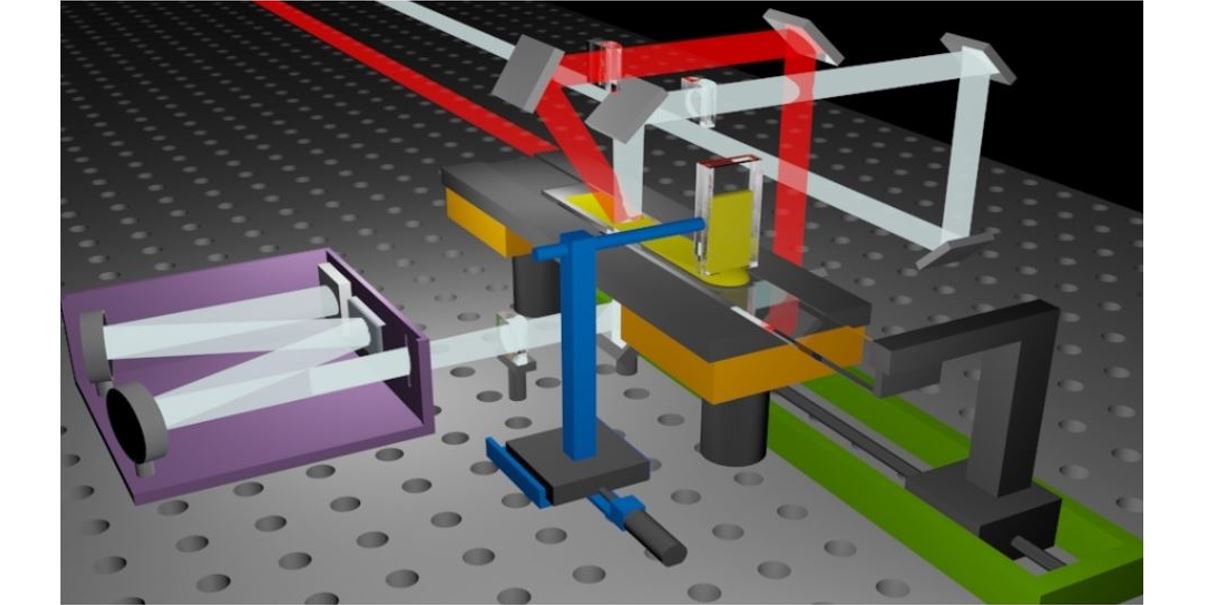Ordered by weight (if set) and creation date.
Research
Tue, 02/13/2018 - 15:23 — cwong3
 We have developed a single-shot transient absorption spectrometer that allows us to measure exciton dynamics in situ during materials formation and other non-equilibrium processes. Transient absorption uses an ultrafast laser pulse to ‘pump’ the sample, creating excited states, then a second laser pulse after a controlled delay time to ‘probe’ the sample. By changing the delay time, we can measure the dynamics of the excited states. We use tilted beams to spatially encode the time delay in our sample, allowing us to measure the dynamics in a single shot, dramatically decreasing the time needed to complete a measurement. This allows us to measure systems that are changing in time, like aggregating organic molecules, or crystallizing perovskites. Our technique can provide insight into the complex processes involved in materials formation, and will show us how we can steer materials to have particular excited state dynamics by changing environmental conditions while the material is being made. We are continually developing and improving the design of our instruments and building new reaction chambers and film deposition stages so we can measure materials formation in our laser lab, and provide valuable feedback for rational materials design.
We have developed a single-shot transient absorption spectrometer that allows us to measure exciton dynamics in situ during materials formation and other non-equilibrium processes. Transient absorption uses an ultrafast laser pulse to ‘pump’ the sample, creating excited states, then a second laser pulse after a controlled delay time to ‘probe’ the sample. By changing the delay time, we can measure the dynamics of the excited states. We use tilted beams to spatially encode the time delay in our sample, allowing us to measure the dynamics in a single shot, dramatically decreasing the time needed to complete a measurement. This allows us to measure systems that are changing in time, like aggregating organic molecules, or crystallizing perovskites. Our technique can provide insight into the complex processes involved in materials formation, and will show us how we can steer materials to have particular excited state dynamics by changing environmental conditions while the material is being made. We are continually developing and improving the design of our instruments and building new reaction chambers and film deposition stages so we can measure materials formation in our laser lab, and provide valuable feedback for rational materials design.
Photovoltaic and optoelectronic materials are often assembled from nanoscale building blocks, such as small organic molecules, quantum dots, or polymers. Different methods can be used to put these building blocks together, but one of the most common and cost-effective methods is deposition from a solution. As solvent evaporates, the individual building blocks get closer together, start to interact, and end up in particular physical arrangements. As components of a system couple together, these physical arrangements can result in disorder and defects, and the group of particles can exhibit collective phenomena that alter the behavior of excitons and carriers in unexpected ways.
Research in our lab seeks to adapt time-resolved exciton spectroscopies to the measurement of nanoscale building blocks during their self-assembly. We will measure electronic structure and exciton dynamics in situ and in real-time as irreversible processes occur, such as crystallization, self-assembly, and chemical bond formation. By measuring and comparing how exciton behavior changes during self-assembly using various solution deposition techniques, we develop strategies to control self-assembly to create materials with designer excitonic properties.
